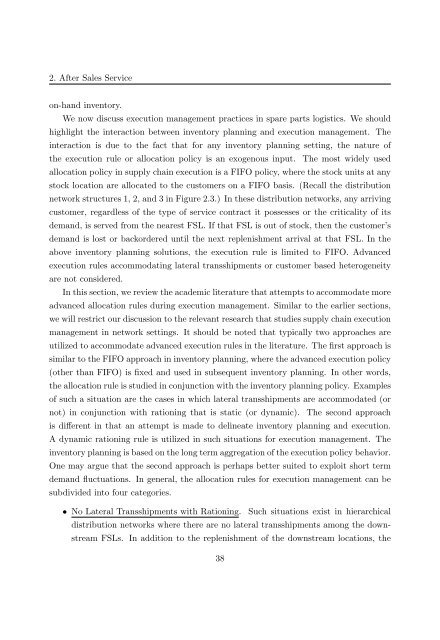Customer Information Driven After Sales Service ... - RePub
Customer Information Driven After Sales Service ... - RePub
Customer Information Driven After Sales Service ... - RePub
You also want an ePaper? Increase the reach of your titles
YUMPU automatically turns print PDFs into web optimized ePapers that Google loves.
2. <strong>After</strong> <strong>Sales</strong> <strong>Service</strong><br />
on-hand inventory.<br />
We now discuss execution management practices in spare parts logistics. We should<br />
highlight the interaction between inventory planning and execution management. The<br />
interaction is due to the fact that for any inventory planning setting, the nature of<br />
the execution rule or allocation policy is an exogenous input. The most widely used<br />
allocation policy in supply chain execution is a FIFO policy, where the stock units at any<br />
stock location are allocated to the customers on a FIFO basis. (Recall the distribution<br />
network structures 1, 2, and 3 in Figure 2.3.) In these distribution networks, any arriving<br />
customer, regardless of the type of service contract it possesses or the criticality of its<br />
demand, is served from the nearest FSL. If that FSL is out of stock, then the customer’s<br />
demand is lost or backordered until the next replenishment arrival at that FSL. In the<br />
above inventory planning solutions, the execution rule is limited to FIFO. Advanced<br />
execution rules accommodating lateral transshipments or customer based heterogeneity<br />
are not considered.<br />
In this section, we review the academic literature that attempts to accommodate more<br />
advanced allocation rules during execution management. Similar to the earlier sections,<br />
we will restrict our discussion to the relevant research that studies supply chain execution<br />
management in network settings. It should be noted that typically two approaches are<br />
utilized to accommodate advanced execution rules in the literature. The first approach is<br />
similar to the FIFO approach in inventory planning, where the advanced execution policy<br />
(other than FIFO) is fixed and used in subsequent inventory planning. In other words,<br />
the allocation rule is studied in conjunction with the inventory planning policy. Examples<br />
of such a situation are the cases in which lateral transshipments are accommodated (or<br />
not) in conjunction with rationing that is static (or dynamic). The second approach<br />
is different in that an attempt is made to delineate inventory planning and execution.<br />
A dynamic rationing rule is utilized in such situations for execution management. The<br />
inventory planning is based on the long term aggregation of the execution policy behavior.<br />
One may argue that the second approach is perhaps better suited to exploit short term<br />
demand fluctuations. In general, the allocation rules for execution management can be<br />
subdivided into four categories.<br />
• No Lateral Transshipments with Rationing. Such situations exist in hierarchical<br />
distribution networks where there are no lateral transshipments among the downstream<br />
FSLs. In addition to the replenishment of the downstream locations, the<br />
38

















